Don’t Ignore These 5 Essential Monstera Care Tips For Incredible Fenestration

HOUSEPLANTS > MONSTERA

Elizabeth is a Permaculture Garden Designer, Sustainability Consultant and Professional Writer, working as an advocate for positive change. She graduated from the University of St. Andrews with an MA in English and Philosophy and obtained a Diploma in Applied Permaculture Design from the Permaculture Association.
Reviewed By COLIN SKELLY

Colin is a Horticulturist and Horticultural Consultant with experience in a range of practical and managerial roles across heritage, commercial and public horticulture. He holds the Royal Horticultural Society’s Master of Horticulture award and has a particular interest in horticultural ecology and naturalistic planting for habitat and climate resilience.
IN THIS GUIDE
MONSTERA GUIDES
Monstera deliciosa, otherwise known as ‘Swiss Cheese Plant’ is a common houseplant to grow indoors.
It is a subtropical plant which I like to place in a bright area indoors – usually with indirect light, and moderate to high humidity.
In certain parts of the UK, it may also be grown in partial shade in a sheltered, frost-free area, but it is more common (and much more straightforward) to grow this subtropical plant as a houseplant in our temperate climes.
Overview
| Botanical Name | Monstera deliciosa |
| Common Name(s) | Swiss Cheese Plant, Ceriman, Custard Plant |
| Plant Type | Houseplant |
| Native Area | Mexico to Panama |
| Hardiness Rating | H1B |
| Foliage | Evergreen |
| Flowers | Lily-like white flowers, followed by conical cream fruit |
| When To Sow (Indoors) | Year-Round |
| Flowering Months | June, July |
Sunlight
Preferred
Partial Shade
Exposure
Sheltered
Size
Height
4 – 8M
Spread
1.5 – 2.5M
Bloom Time
Spring / Summer
Soil
Preferred
Most Soil Types
Moisture
Moist but well drained
pH
Any
This species of flowering plant is native to subtropical and tropical forests in Mexico and further south as far as Panama.1Lachelin, L. (n.d.). Monstera deliciosa. Oxford University Plants. Retrieved March 21, 2023, from https://herbaria.plants.ox.ac.uk/bol/plants400/Profiles/MN/Monstera
Its common name as a houseplant ‘Swiss cheese plant’ comes from the holes that develop in the leaves, which resemble the holes in some Swiss cheeses.
The same name is also sometimes applied to Monstera adansonii, which also has holes in the leaves.

However, Monstera deliciosa is more common and is the main subject of this article.
The holes develop through a process known as ‘fenestration’.2Muir, C. D. (2013). How Did the Swiss Cheese Plant Get Its Holes? The American Naturalist. https://doi.org/10.1086/668819
It is believed that the holes develop as a mechanism to allow as much light as possible through to lower foliation.
M. deliciosa takes its botanical name from ‘monstrous’ – a reference to the large size to which this plant can grow in its native range – and ‘delicious’, a reference to the edible fruit.3Barwani, A. (2022, November 21). The Swiss Cheese Plant: Monstera deliciosa. Capital Gardens. Retrieved March 21, 2023, from https://www.capitalgardens.co.uk/blog/the-swiss-cheese-plant-monstera-deliciosa/#:~:text=Mature%20Monstera%20leaves%20have%20numerous,name%20%E2%80%93%20The%20Swiss%20Cheese%20Plant.

Unfortunately, however, while the plant flowers readily in the subtropics and tropics, forcing it to flower and fruit outside its native range proves extremely difficult.
Specific conditions need to be met for the plant to flower, and it is very rare to see this in the UK or elsewhere when the plant is grown indoors.
The M. deliciosa is a member of the arum family (Araceae).4Monsteras and more: at home with arums. (n.d.). Royal Horticultural Society. Retrieved March 21, 2023, from https://www.rhs.org.uk/garden-inspiration/houseplants/monsteras-and-more
It is an epiphyte climber, with aerial roots.5Kelly, P. (n.d.). What Are Epiphytes? Jacksonville Zoo and Gardens. Retrieved March 21, 2023, from https://www.jacksonvillezoo.org/blog/posts/what-are-air-plants
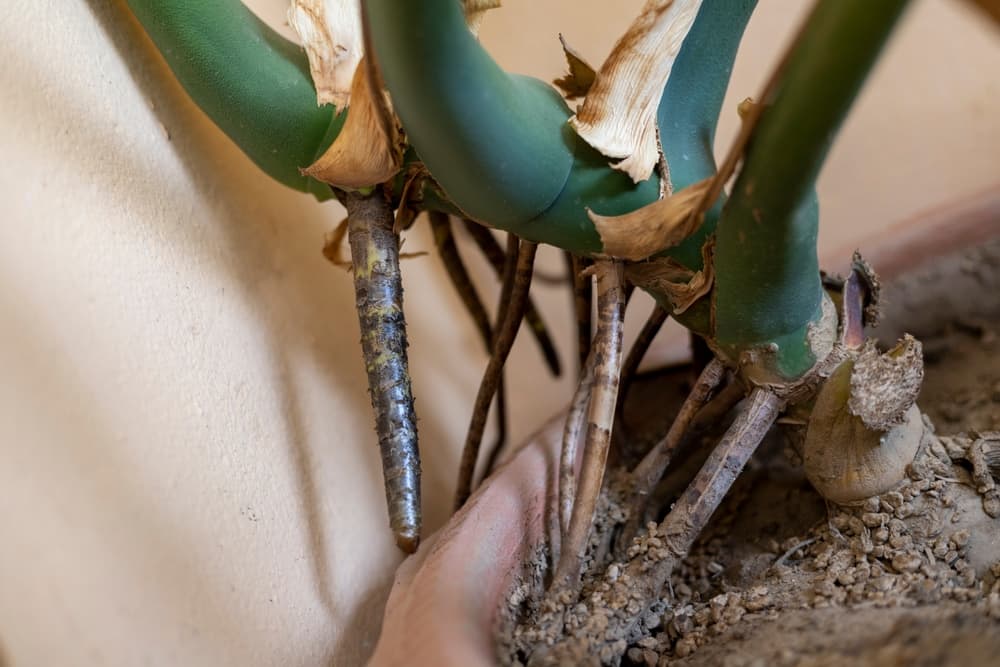
In its native range environment, it can grow up to 20M high, growing up trees towards the light.
Even in indoors cultivation, it is a large plant, which can grow to 4-8M and 1.5-2.5M in width if given the opportunity (and grown in a large enough container).
Why Grow A Swiss Cheese Plant?
M. deliciosa can be a dramatic houseplant – wonderful for adding to an interior design, in a home or office space.
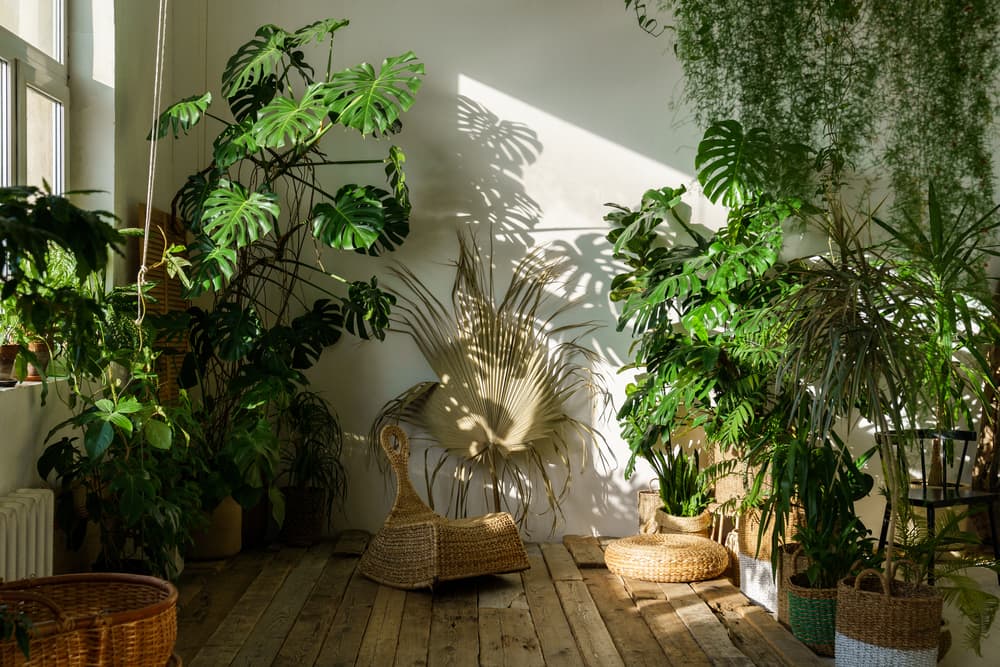
It has large glossy leaves, and looks fantastic inside a home of work place.
Its architectural qualities mean that this is a plant that can tie a room together.
Swiss cheese plant is ideal for growing inside because it can tolerate a reasonably wide range of conditions.
It can cope with bright, indirect light and will thrive at temperatures between 20-30°C.
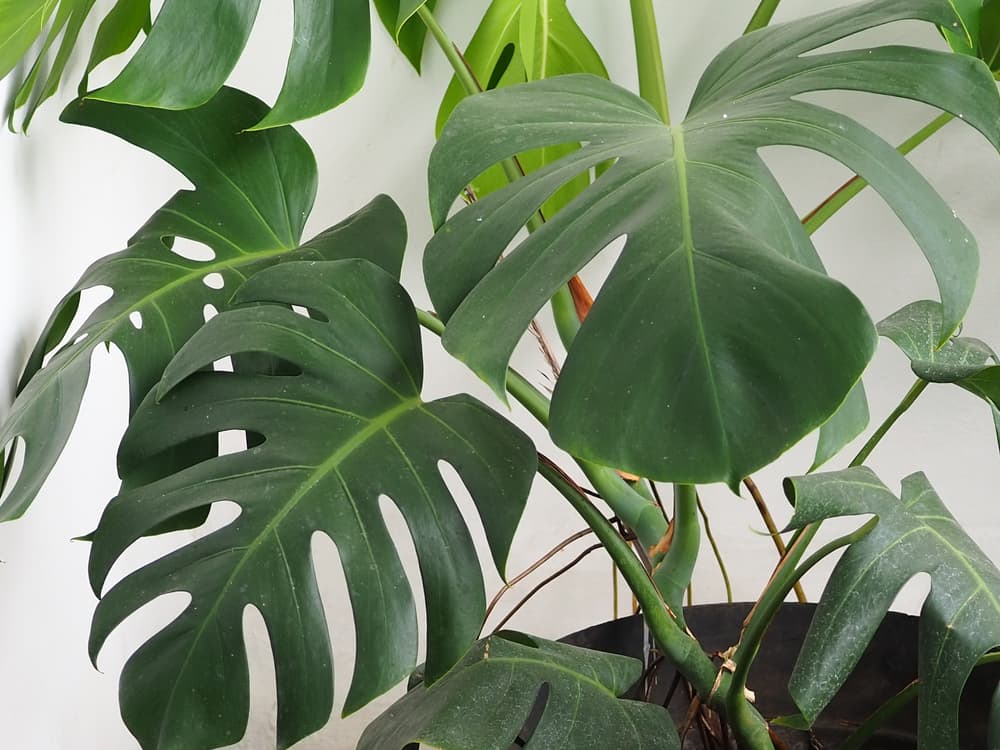
However, they will continue to grow at temperatures over 18°C – and can survive down to as low as around 10°C (M. deliciosa has an RHS hardiness rating of H1B).6Monstera deliciosa (F) | Swiss cheese plant. (n.d.). Royal Horticultural Society. Retrieved March 21, 2023, from https://www.rhs.org.uk/plants/11192/monstera-deliciosa-(f)/details
They can endure for numerous years when provided with the appropriate conditions.
1) Grow Them In Bright, Indirect Sunlight
Swiss cheese plants are usually plants which require very little care.
The most crucial thing is to make sure they are in a light location, but not in direct sunlight.
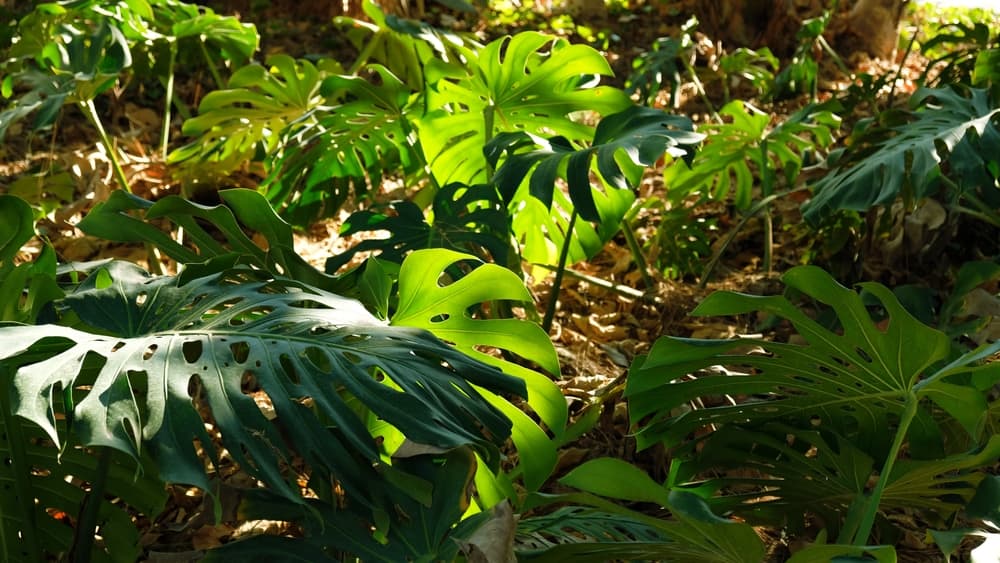
I find that it is best to position your plant a few feet away from a window that lets in plenty of light.
Remember that your plant will need plenty of room to grow.
Do not place your houseplant too close to a radiator, stove, or other heat source – or, near the draft from a door, window, fan, or air conditioning unit.
Fenestration
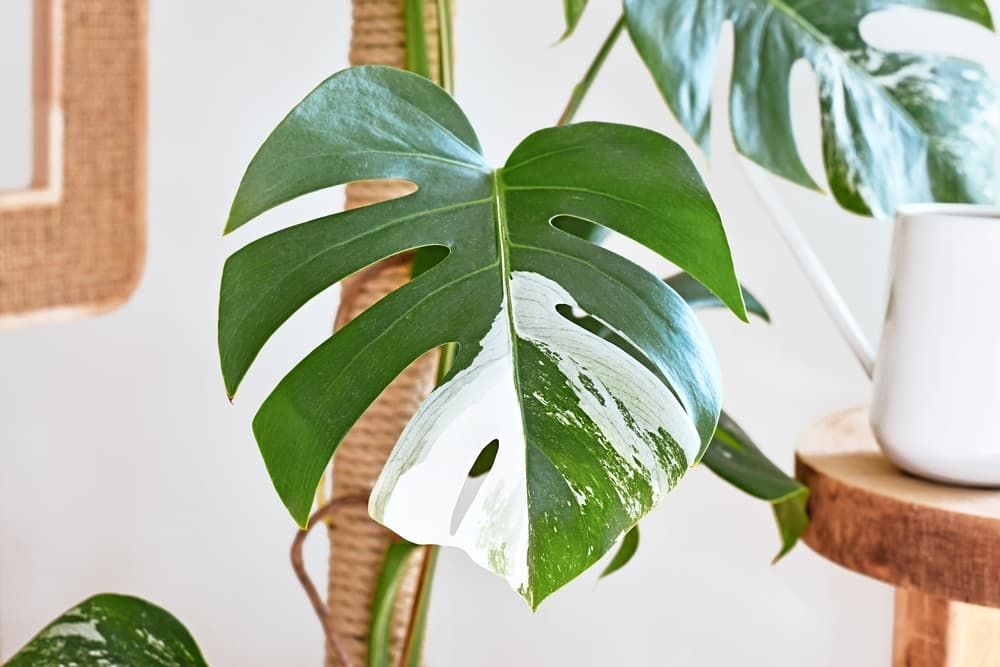
If larger leaves do not show holes (‘fenestration’) then this can be because there is not sufficient light.
“Think about a forest canopy where shafts of light break through the branches above,” says Master Horticulturist Colin Skelly.
“This is the environment you are trying to replicate for your Monstera.”
Younger leaves will not perforate immediately, but mature leaves should do so.
If mature leaves do not have holes, move the plant to a brighter spot.
Brown patches on the leaves can be due to scorching from the sunlight – move the plant out of direct sunlight if you encounter this problem.
2) Make Sure There Is Sufficient Drainage
As well as finding the right location for your M. deliciosa, it is also important to choose the right container and growing medium.
The container should be deep, and have drainage holes at the base.
A heavier container (such as a terracotta or stoneware pot) is ideal, since it will be less likely to tip over and better able to support the weight of the plant as it grows.
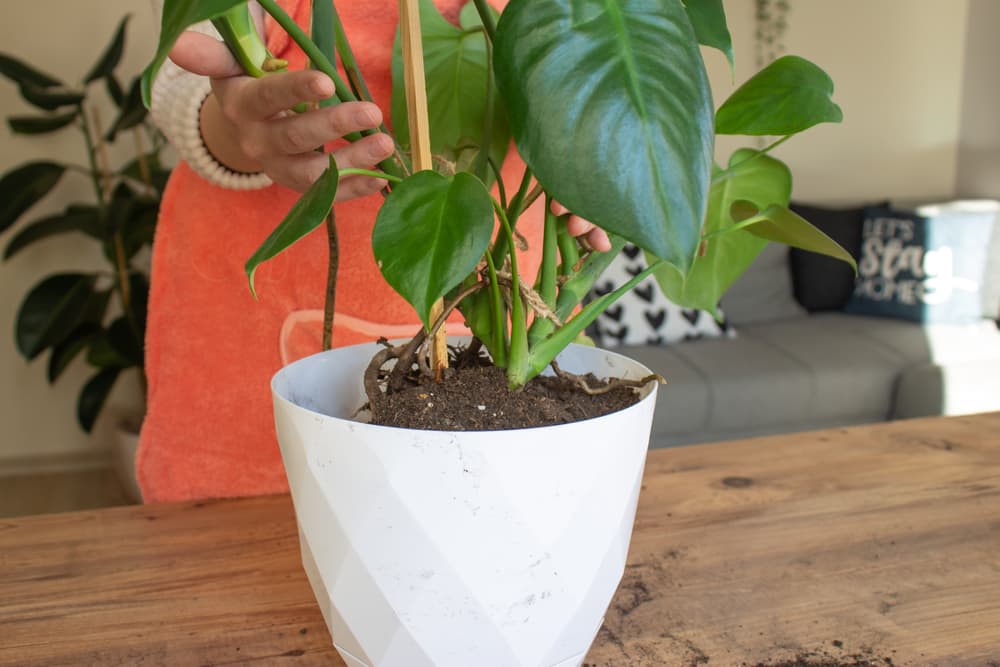
Remember, as a climber, a Monstera will ultimately need a moss or coir pole as support to cling to with its aerial roots.
The container should be filled with a peat-free, all-purpose compost or similar.
You should make sure that there is a minimum of one inch of medium around the root system of the plant in all directions.
3) Water When The Top 2 Inches Are Dry
One of the most common mistakes people make with this easy and low-maintenance plant is watering too much.

It is better for the soil to be on the dry side; how often you will need to water will depend on where exactly you live, the temperatures, season, light levels and other conditions.
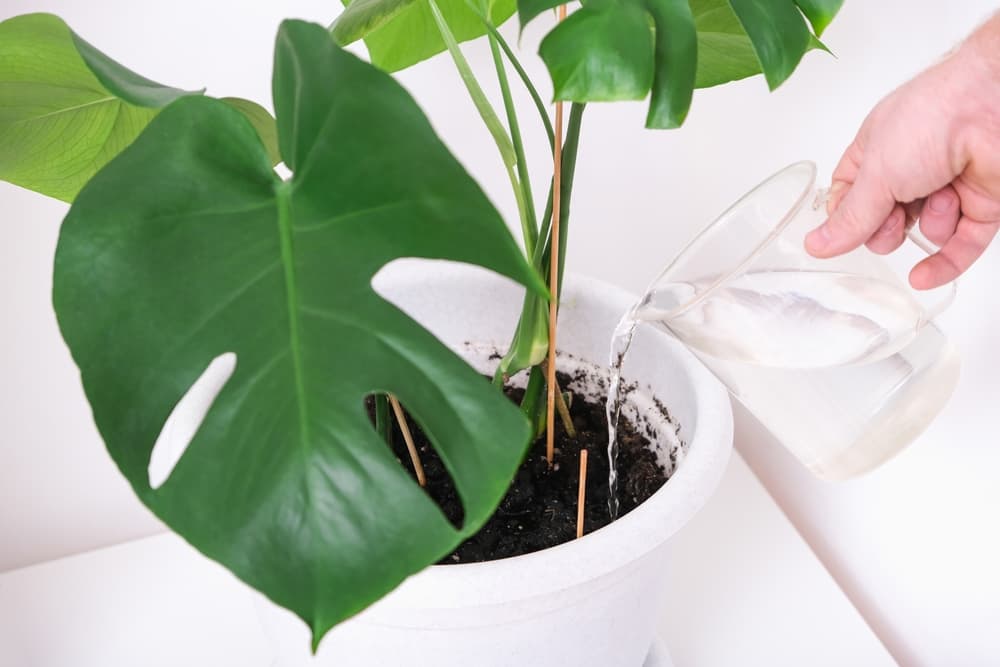
Without any outsider knowledge, you will have to rely on your own finger:
- Stick it into the growing medium to see whether the top two inches of the compost mix is dry.
- When they are, you should water well.
- Always allow the water to completely drain through afterwards – don’t let your plant sit with wet feet.
Remember, your houseplant will typically require far less water during the winter months, especially if you place it in a cooler room.
If you water too much, or the excess water does not drain away properly, you may see leaves yellowing and wilting.
You may also see ‘tears’ of water at the edges of the leaves.
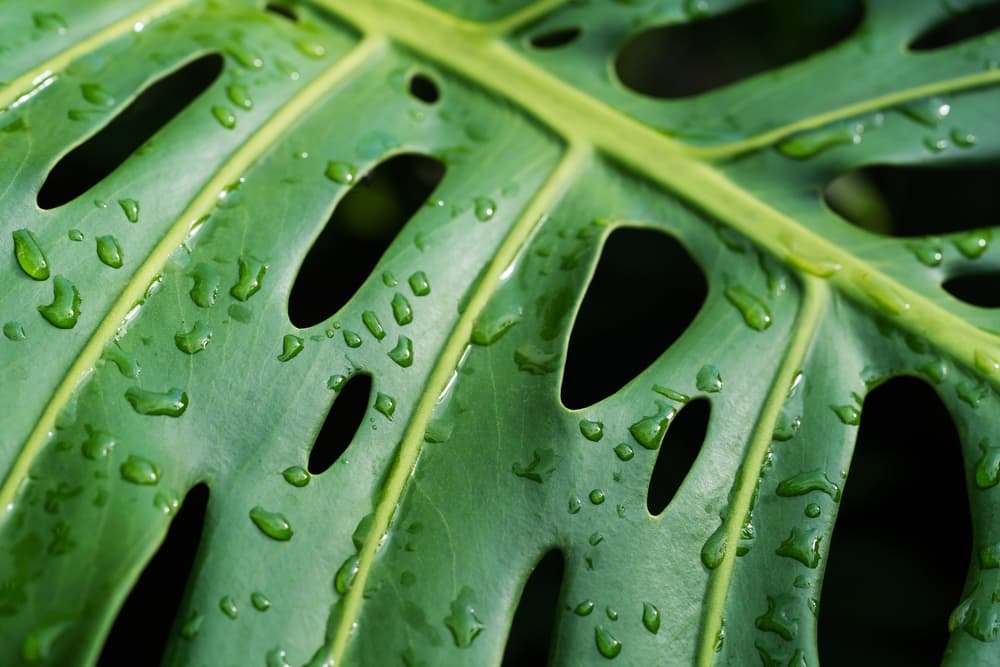
The compost should always be just damp, and never waterlogged.
Wilting leaves may be a sign of a problem – showing that you are watering either too much or too little.
Check the growing medium to see whether it is too wet or too dry – and also take a look at the roots – it may be time to repot.
It can be a good idea, for best results, to feed your plant with an organic houseplant feed around once a month during the spring and summer.
4) Wipe Your Leaves And Mist To Maintain Humidity
Since the plants need sunlight for photosynthesis, it is important to keep them clean so the light can get through.
The large leaves on a M. deliciosa will tend to attract dust, so it is important to give them a wipe every now and then with a damp cloth.
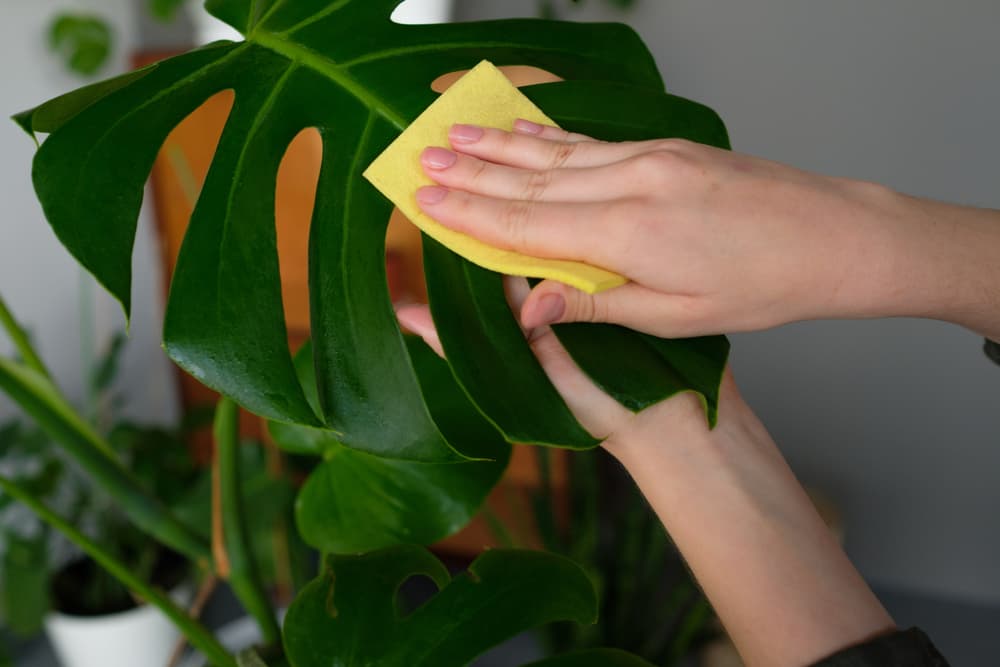
This will keep them looking good – but more importantly, allow plant processes to continue as they should.
Wiping over with a damp cloth can also help to keep up humidity levels around the plant.
In a dry, centrally heated space, it can also be beneficial to mist the leaves from time to time to keep the humidity up in a drier environment.
5) Take Cuttings In Summer To Clone Your Plant
You can also very easily take cuttings from a mature plant – perhaps to give away the mature plant to someone with more space, or to increase your houseplant collection.
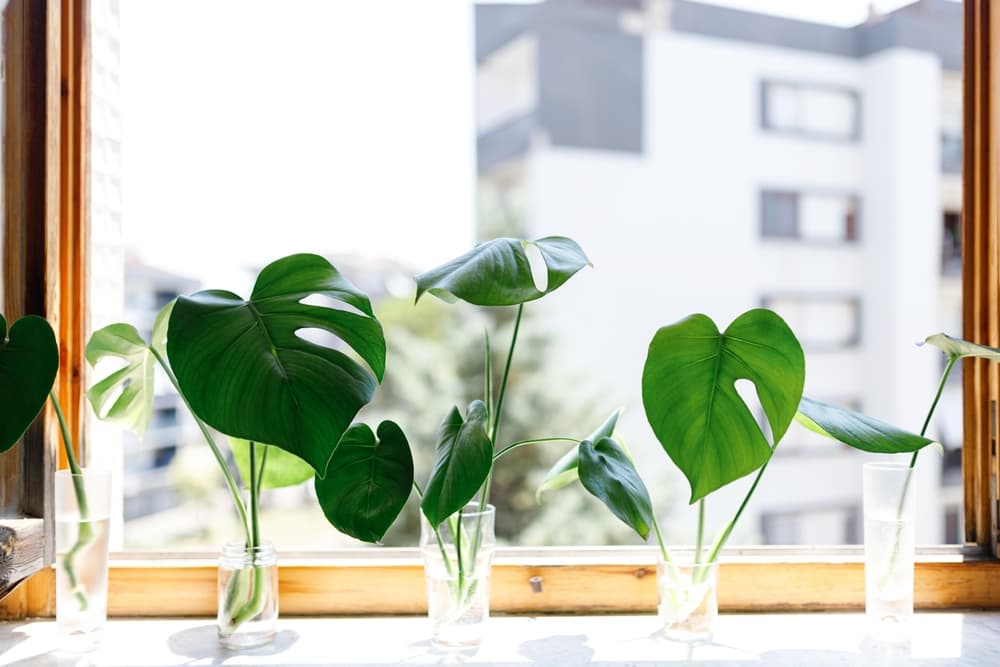
Cuttings can be taken in springtime or early in summer:
- Choose a stem which has aerial roots beginning to grow in its lower portion.
- New roots grow from the white or brown buds across from a leaf.
- Using a sharp implement, slice through the stem an inch or so below the aerial root.
- Place this stem into a container with a little water in the base, so the aerial root is underwater.
- Place this container in a bright spot out of direct sunlight.
- Replace the water every couple of days, and after 1-2 weeks, new roots should emerge.
- After lots of roots have formed (usually after 4-6 weeks have elapsed) you can take your cutting and pot it up.
References
- 1Lachelin, L. (n.d.). Monstera deliciosa. Oxford University Plants. Retrieved March 21, 2023, from https://herbaria.plants.ox.ac.uk/bol/plants400/Profiles/MN/Monstera
- 2Muir, C. D. (2013). How Did the Swiss Cheese Plant Get Its Holes? The American Naturalist. https://doi.org/10.1086/668819
- 3Barwani, A. (2022, November 21). The Swiss Cheese Plant: Monstera deliciosa. Capital Gardens. Retrieved March 21, 2023, from https://www.capitalgardens.co.uk/blog/the-swiss-cheese-plant-monstera-deliciosa/#:~:text=Mature%20Monstera%20leaves%20have%20numerous,name%20%E2%80%93%20The%20Swiss%20Cheese%20Plant.
- 4Monsteras and more: at home with arums. (n.d.). Royal Horticultural Society. Retrieved March 21, 2023, from https://www.rhs.org.uk/garden-inspiration/houseplants/monsteras-and-more
- 5Kelly, P. (n.d.). What Are Epiphytes? Jacksonville Zoo and Gardens. Retrieved March 21, 2023, from https://www.jacksonvillezoo.org/blog/posts/what-are-air-plants
- 6Monstera deliciosa (F) | Swiss cheese plant. (n.d.). Royal Horticultural Society. Retrieved March 21, 2023, from https://www.rhs.org.uk/plants/11192/monstera-deliciosa-(f)/details
